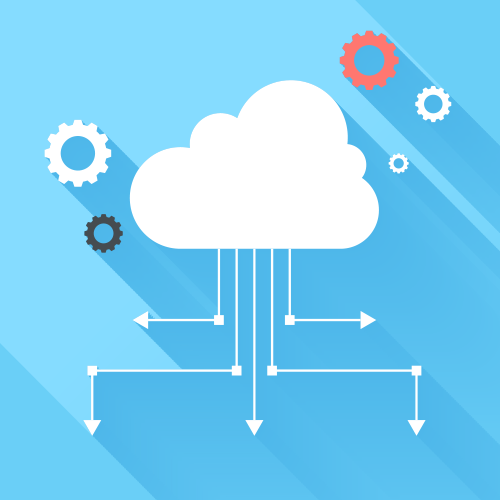Improving efficiency, delivering value, and maintaining security are top of mind for most Managed Service Providers (MSPs), and many are reevaluating how their identity and access management (IAM) offering fits in. Many MSPs are no longer interested in the time sinks and cumbersome workflows that accompany traditional on-prem identity management solutions. They’re ready for this part of their environment to shift to the cloud, and so are their clients. It’s a smart move since the cloud has proven to save organizations money and time, all the while increasing innovation and efficiency.
So let’s take a look at 5 reasons why MSPs should use Cloud IAM.

5 Reasons to Use Cloud Identity Management
1. Efficiency
While the motto “time is money” hits home for just about any business, it’s especially true for MSPs. Efficiency is key, and cloud identity management in particular is one tool MSPs can employ to cut down on wasted time.
First, cloud IAM completely eliminates the need for on-prem identity management hardware, so right off the bat, MSPs have one less thing they need to babysit. Since there isn’t any on-prem hardware, MSPs can remotely resolve most issues that arise. So, instead of using time to commute to client sites, MSPs can take that time and put it towards preventing issues from ever even occurring.
Additionally, MSPs don’t have to use their time for tasks related to the security, reliability, configuration, and maintenance of the IAM platform. In the spirit of the “as-a-service” model, that’s the responsibility of the cloud identity provider. This enables MSPs to focus more of their time on ensuring client environments operate smoothly, driving business value for their clients, and integrating the best technology to provide a complete solution for their customers.
Finally, a modern, comprehensive cloud IAM tool can centralize the management of systems, applications, file storage, and networks regardless of where they are and what protocols and platforms are leveraged. Where efficiency gains are concerned, a centralized environment means MSPs can manage their client environments from one pane of glass, and they no longer have to jump to and from solutions. Even if an MSP has one client that is an all Mac shop, and another that is a mix of Windows, Mac, and Linux, for example, the MSP will still be able to manage both of them using the same IAM solution. MSPs don’t have to continually reorient themselves to a platform when switching between clients. Instead, all of the settings, all of the buttons, and all of the functionality remains the same. Efficiency is just one benefit of a centralized environment, so expect to read more about centralized IT here shortly.
Before moving on from this value, though, let’s discuss the benefits clients experience. After all, the only thing more important to an MSP than bringing value to their business is, bringing value to their clients, and the efficiencies that come with cloud identity and access management extend to clients as well. For example, a client’s end users don’t have to jump through hoops to change their password. This can easily be taken care of by the end user themself. Additionally, when technical issues arise, MSPs can resolve them remotely, and therefore much more quickly compared to having to travel onsite to fix an issue. So any hurdles can be addressed quickly without much loss in productivity. And again, the right cloud IAM solution will support all IT resources regardless of platform, provider, protocol, and location. With respect to efficiency, this means a client’s end users will only need one set of credentials to access all of their IT resources, creating a frictionless IAM workflow.

2. Resiliency
In addition to being efficient, MSPs must ensure their client’s IT environment remains secure and highly available. In other words, that’s why good MSPs aim for resilience at every potential “point of failure.”
With an on-prem identity management solution, ensuring resilience and redundancy is expensive. Authentication is a 100% uptime business, so it requires double the amount of hardware, software and networking gear, multiple internet connections, and more. This way, if one instance fails for some reason, another instance can take over. Not only can this be expensive, but it’s not exactly foolproof either. For example, let’s say an MSP client has multiple office locations, and one of them gets destroyed by a fire. If that client office held the on-prem data center the identity management hardware will go down with it, and work will come to a standstill.
Cloud IAM doesn’t require any on-prem hardware or software. Instead, a cloud IAM solution will leverage the redundant infrastructure of IaaS providers. If a catastrophe occurs in one location, the cloud identity provider will still be available because it’s spread across multiple zones and regions. A client’s authentication service will always be available.

3. Centralization
The days of homogeneous IT environments are over, and forward-thinking cloud IAM solutions are built with that in mind. Today, most organizations are using a mix of Linux®️, Mac®️, and Windows®️ systems; cloud and local servers; LDAP and SAML based applications; an array of data storage solutions including cloud options (Box™ or Dropbox™) and physical Samba-based file storage (NAS, Synology); wired and WiFi networks; and more. An effective cloud identity provider supports all of these IT resources. For MSPs, this is critical because they are responsible for managing multiple IT environments/solutions. So, if they can centralize every single one, they will see incredible gains in efficiency, stronger security, and an easier time responding to technical issues.
The value for clients, on the other hand, is that they don’t have to change their environment to fit with the cloud IAM tool (or when working with an MSP). Whether they prefer G Suite™ or Office 365™, for example, they can use whatever is best for them because the cloud IAM solution and MSP can adapt to their environment. MSPs don’t have to force their clients to switch tools or apps based on the fact that the MSP’s preferred identity provider only supports one protocol or platform.
The other implication is that this opens up the doors for what kinds of clients MSPs can support. With a cloud IAM tool that can support virtually all IT resources, MSPs can offer their services to almost any client because they know they’ll be able to adapt their IT management tool stack to accommodate anything.

4. Scalability
Cloud identity management also makes it easy to scale – and that’s not just because of the lack of on-prem hardware. Some cloud IAM tools in particular offer powerful APIs, PowerShell “interfaces”, group-based system management, and security policies that make it a breeze to make changes and enforce security standards in bulk. This makes it easy to support clients whether they have 5 users, 500 users, or 5,000 users. Not only is it easy to support clients of all sizes, but as MSPs continue to grow their client base, the work doesn’t get harder because of the efficiencies in place. This means MSPs can take on more clients without having to take on more staff.

5. Security
The fastest way to go out of business as an MSP is to have a client become the victim of a data breach. Maintaining a reputation for security is essential. These days, user identities are the keys to a company’s digital kingdom: a single set of credentials can do irrevocable damage in the wrong hands. Identity management is therefore central to an organization’s overall security strategy. Though some clients may associate the cloud with security risks, MSPs know that cloud IAM offers distinct security advantages compared to its on-prem counterparts. For one, a cloud-based identity management provider assists organizations with enforcing practical identity security measures such as implementing MFA on systems and applications, utilizing complex passwords, and requiring SSH keys where applicable. Additionally, a cloud identity provider that integrates with virtually all of an organization’s IT resources provides MSPs with precise control over every client environment, from one pane of glass. Clients no longer have to stress over resources remaining outside their MSPs purview, and when an employee leaves, it’s quick and easy to revoke their access to company data. Furthermore, cloud identity and access management solutions offer tools that provide accurate, precise logs of who accessed what, when, and where. This data makes it easy to monitor what’s going on operationally, pass compliance audits, and remain aware of security incidents.

Why MSPs Should Use Cloud IAM with JumpCloud

First, JumpCloud offers a Multi-Tenant Portal that creates a frictionless workflow for MSPs. In the same login session, they can easily move from one client’s environment to the next, all with a few clicks. Second, JumpCloud is completely cloud-based. It doesn’t require any on-prem hardware or software, so MSPs and their clients can shift completely to the cloud. Third, JumpCloud integrates with virtually all IT resources regardless of protocol, provider, platform, and location. This means MSPs can adapt JumpCloud to work in any client environment they encounter. Cloud IAM with JumpCloud is also easy to scale. In addition to the Multi-Tenant Portal, the PowerShell Module, group-based system management, and JumpCloud’s APIs help streamline an MSPs workflow. These tools make it quick and easy to implement changes across hundreds of users and systems. Next, along with powerful efficiency gains, JumpCloud enables MSPs to empower their clients with robust security measures. From MFA and password complexity management to remote system policy management, JumpCloud offers rich features that can help MSPs and their clients further lock down their environments. MSPs clearly gain tremendous value by incorporating JumpCloud’s cloud IAM solution into their offering, but how does this value translate to their clients?.
How JumpCloud Provides Value for MSP Clients
Foremost, MSP clients gain tremendous value with the amount of features JumpCloud offers for one price, in one solution. JumpCloud Directory-as-a-Service offers user and system management, True SSO, LDAP-as-a-Service, RADIUS-as-a-Service, MFA, directory integrations with G Suite and Office 365, and even more. Clients can leverage all of this for one simple price.
The next point of value relates to efficiency gains. Instead of a multitude of passwords to stress over, for example, users gain one set of credentials to seamlessly access all of their IT resources. Additionally, onboarding new hires no longer takes a week. Instead, in just a few hours, a new hire can receive access to everything they need to do their job—starting from day one.
Finally, clients gain superior resiliency and redundancy. Because JumpCloud is completely cloud-based, a client’s identity management is always on and highly available. Some of JumpCloud’s resiliency plan includes leveraging cloud infrastructure providers across several geographic regions and availability zones, and in the case of a disaster, configuration automation tools to rapidly provision new infrastructure in a non-impacted zone. In any case, JumpCloud aims to be resilient in the face of any number of catastrophic scenarios.
These gains in efficiency, value, and security have not gone unnoticed. Hundreds of partners and their clients have embraced working smarter, not harder, thanks to implementing JumpCloud Directory-as-a-Service. If you are interested in further discussing the 5 reasons why MSPs should use cloud IAM, contact one of our product experts. They will be happy to answer any remaining questions. Interested in becoming a JumpCloud partner? Submit a Partner Application, try a demo, or start your research with the video playlist above.
